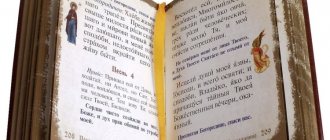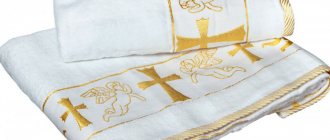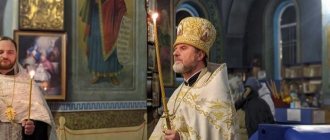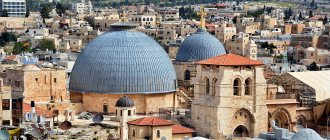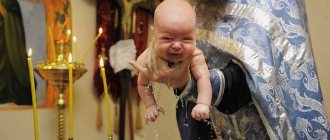Any Orthodox Christian has gone through the rite of baptism. A prayer for the baptism of a child for godparents for a girl or a boy is a must-learn for those who participate in this sacrament! During baptism, a person is born again spiritually. Initially, we are all born in sin, and after baptism all our sins are forgiven. During baptism, God's grace descends on the child. At what age parents decide for themselves to baptize their child. You can be baptized 40 days after birth, earlier or later. But it is worth considering that up to 3 months, dipping into the font is easier for a baby to tolerate due to the preservation of newborn reflexes for up to 3 months.
What prayer is read at the baptism of a child? What prayers should godparents know before baptizing a child? Text of prayers to the Symbol of Faith and the Mother of God.
The importance of godparents in the fate of a child is no less than that of parents. Godparents become his second parents in heaven, they teach him spiritual life, prayers, and guide him to God in every possible way.
Prayers for godparents
Doubts often arise about who can become a godmother/godmother. What prayers should a godfather and mother know and read? The most important condition is that godparents must be Orthodox Christians; in the future, they will be responsible for raising the child in the faith; the child’s parents cannot become godparents, because if something happens to the parents, godparents will be able to replace them. Also, spouses cannot be godparents of one child, and a monastic cannot be godparent. It is also not necessary for a child to have two godparents, there can be one of each - the boy has a godfather, the girl has a godmother.
Do you want to find the Prayer you need? Use the search...
Popular queries: “Our Father”, “99 names of God”, “Creed”, “Heavenly King”, “Psalm 50”, “Psalm 90”;
What prayers should you know?
Godfather
Lord Jesus Christ, be Your littleness on my godson (goddaughter) (name), keep him (her) under Your roof, cover him (her) from all evil lust, drive away from him (her) every enemy and adversary, open to him (her) ) ears and eyes of the heart, grant tenderness and humility to his (her) heart.
Save, Lord, and have mercy on my godson (my) (name), and enlighten him (her) with the light of reason of Your Holy Gospel and guide him (her) on the path of Your commandments and teach him (her). Savior, do Thy will, for Thou art our God, and to Thee we send glory, to the Father and the Son and the Holy Spirit, now and ever and unto ages of ages. Amen.
In addition to prayers for children before baptism, the following can be read to godparents:
Sweetest Jesus! God of my heart! You gave me children according to the flesh, they are Yours according to your soul. You redeemed both my soul and theirs with Your priceless Blood. For the sake of Your Divine Blood, I beg You, my sweetest Savior, with Your grace touch the hearts of my children (names) and my godchildren (names), protect them with Your Divine fear, keep them from bad inclinations and habits, direct them to the bright path of life, truth and of good. Decorate their lives with everything good and saving, arrange their fate as You yourself want and save their souls with their own destinies! Lord, God of our fathers! Give to my children (names) and godchildren (names) a right heart to keep Your commandments, Your revelations and Your statutes. And do it all! Amen.
Parents
God, our merciful and heavenly Father! Have mercy on our children (names), for whom we humbly pray to You and whom we entrust to Your care and protection. Put strong faith in them, teach them to revere You and deign them to deeply love You, our Creator and Savior. Guide them, God, on the path of truth and goodness, so that they do everything for the glory of Your name. Teach them to live piously and virtuously, to be good Christians and useful people.
Give them mental and physical health and success in their work. Deliver them from the cunning machinations of the devil, from numerous temptations, from evil passions and from all wicked and disorderly people. For the sake of Your Son, our Lord Jesus Christ, through the prayers of His Most Pure Mother and all the saints, lead them to the quiet haven of Your eternal Kingdom, so that they, along with all the righteous, will always thank You with Your only begotten Son and Your life-giving Spirit. Amen.
If you find an error, please select a piece of text and press Ctrl+Enter.
First prayer for godparents: “Creed”
Before the christening, godparents must attend conversations in the church, after which they will be issued a certificate. During the conversations, the priest will tell them about Christ, the meaning of godparents, how to raise a child in the faith, and talks about the rite of baptism.
Godparents should memorize the “Creed” prayer; during baptism it is read three times and there is a high probability that godparents will be asked to read it. When the baptism ceremony is over, the parents in the church are given a certificate of baptism, which will indicate who the godparents are and who performed the baptism.
Text of the baptismal prayer
The “Creed” prayer is one of the main prayers read during the sacrament of baptism. This prayer describes in detail what a Christian believes in, what is important to him. It contains all the basics of Christianity and helps to understand the essence of the Christian faith.
Prayer of godparents for godson (tsu)
In addition to the “Creed” prayer, godparents should learn a prayer for their godson/goddaughter and read it every evening. This prayer is a request to God to protect the godson, to help him in all his endeavors and not to abandon him during all the difficult days and nights. If you are godparents. do not neglect such a prayer, you have taken responsibility before God for your godson, remember him, pray for him, visit him, participate in his upbringing and education about God.
Text of prayer for the godson
If your godson does not know how, teach him to pray, help him learn the prayers - “Our Father”, “Creed”, “Virgin Mary”, “Prayer to the Guardian Angel”. Go to the temple with him. Don't neglect all these responsibilities of godparents. It often happens that godparents do not find time to meet with their godson and, unfortunately, “buy off” him with gifts for the holidays. This is a very common situation, but it is not correct. It is imperative to communicate with godchildren, instruct them, accustom them to the Faith, and nourish their love for God.
Chapter II. Divine service of the Sacraments of Baptism and Confirmation
The Gospel of John says: “On the last great day of the feast, Jesus Christ cried: “If anyone thirsts, let him come to Me and drink. Whoever believes in Me, as the Scripture says, out of his heart will flow rivers of living water.” This He said about the Spirit, which those who believed in Him were about to receive.” (John 7:37–39).
On the day of Pentecost, the apostles accepted the gift of the Holy Spirit and on the same day began to teach it to those who believed in Jesus Christ. “Let every one of you be baptized,” the Apostle Peter said to the people that day, “and you will receive the gift of the Holy Spirit” (Acts 2:38).
Initially, the apostles, through prayer and the laying on of hands, brought down the Holy Spirit on those “who gladly received” (Acts 2:44) the word of the gospel and those who were baptized. The Book of the Acts of the Apostles tells that the apostles Peter and John performed this Sacrament over the Samaritans. Having come to them, the apostles prayed for them so that they would receive the Holy Spirit (Acts 8:15-17). And the Apostle Paul sent down the Holy Spirit on the baptized disciples of John the Baptist: “When Paul laid his hands on them, the Holy Spirit descended on them” (Acts 19: 2-6).
The need to perform the Sacrament of the Spirit through the laying on of hands required the personal participation of the apostles in the Sacraments. Having dispersed with the preaching of the Gospel throughout the whole earth, the apostles blessed the bishops and presbyters they had appointed to bring down the Holy Spirit on the believers through the anointing of the chrism, and to consecrate the chrism only to bishops. In their actions, the apostles of Christ were always guided by the Holy Spirit, who guided them into all truth and reminded them of everything that the Lord commanded (John 16:13; 14:26). And the replacement of the laying on of hands with anointing had therefore a God-ordained meaning.
The word "mirror" in Greek means "fragrant oil." Myrrh was used for sanctification back in the days of the Old Testament. Moses, for example, when consecrating the tabernacle of the Lord, used myrrh for this. Aaron was anointed with this substance for his high priestly service (Lev. 8:10–12). All subsequent Old Testament high priests, as well as prophets, were anointed with chrism when entering into the service of the Lord. The composition of the world for sacred anointing was indicated to Moses by God Himself (Ex. 30, 22–25). The Holy Scripture calls the preparation of the world a holy work, and the world itself is “great sanctuary” (Ex. 30:32).
The use of peace in the Sacrament of the sending down of the Holy Spirit was perceived by church communities as very appropriate. Bishops and presbyters, appointed by the apostles to shepherd the flock of Christ, performed the Sacrament of Confirmation. “You have the anointing from the Holy One and you know everything,” writes the Apostle John the Theologian in his First Catholic Epistle, “... the anointing that you received from Him abides in you, and you have no need for anyone to teach you; But just as this very anointing teaches you all things, and is true and not false, whatever it has taught you, continue in it” (1 John 2:20,27). The Apostle Paul says the same about the use of the world: “He who established you and me in Christ and anointed us is God, who sealed us and gave the deposit of the Spirit into our hearts” (2 Cor. 1:21-22).
Anointing (χριδμα) has its sacramental significance through another sacred act that precedes it - sealing - the sign of the cross performed over the holy world. “I put a seal”, “I seal” - was understood by Christian writers to mean “I sign”, “I make the sign of the cross”. The expression “into our hearts” indicates the anointing of the chest with holy myrrh, as the part of the body closest to the human heart, the dwelling place of the grace of the Holy Spirit87
The Church has always performed the Sacrament of Confirmation as an independent one, but in connection with Baptism. In the 4th century, the Sacrament was performed through confirmation immediately after Baptism (Laod. Sob. 48 rights). With this anointing, various parts of the body were imprinted: forehead, nostrils, ears, chest - with the words pronounced: “Seal of the gift of the Holy Spirit. Amen" (2 Ecumenical Law. 7). The anointing itself was performed in the form of a cross.
In the Breviaries of the Orthodox Church, the rite of this Sacrament is printed together with the rite of Baptism under the general title “Consequence of Holy Baptism.”
The Sacrament of Confirmation consists of two separate sacred rites: 1) the preparation and consecration of the world and 2) the actual anointing of the newly baptized with the consecrated Chrism, which is performed by the priest immediately after the Sacrament of Baptism. Despite the fact that these two sacred rites are separated from each other in time, there is the same internal organic connection between them as between the consecration of the Holy Gifts and the communion of the faithful with them in the Sacrament of the Eucharist.
In the Ancient Church, the Sacrament of Confirmation was not isolated as an independent rite. It, together with Baptism, formed a single whole and was in close organic connection with the Sacrament of the Eucharist. Since the time of Equal-to-the-Apostles Constantine the Great (IV century), the Baptism of catechumens has been performed on great holidays: the eve of Easter, the feasts of the Nativity of Christ and the Epiphany, the Holy Trinity, the Ascension, the Transfiguration, the Entry of the Lord into Jerusalem and the Renewal of the Temple in Jerusalem.88 Most often, the time of Baptism was Holy Saturdays and the holidays of the Nativity of Christ and Epiphany, because the previous fasts provided an opportunity for the catechumens to prepare for the acceptance of the Christian faith through repentance and the assimilation of the basic dogmas of the Church. In the Church of Constantinople, after receiving the Sacrament of Baptism, the newly baptized, singing “Elitsa were baptized into Christ,” went from the baptismal to the temple, led by the clergy and accompanied by their recipients, holding lighted candles in their hands. In the church, in the presence of the entire church congregation, the Sacrament of Confirmation was performed on the newly enlightened, and they participated in the Eucharist for the first time.
In the Russian Church in the 11th-12th centuries, the Sacrament of Confirmation was performed in two versions. According to the rule of Sava (an unknown bishop), the forehead, nostrils, lips, ears, heart and one hand were anointed. According to the rule of Nifont, Bishop of Novgorod, these are the same parts of the body with the exception of the mouth.89 The performance of the Sacrament by Bishop Nifont is presented in the following form: “Put on the robe of the cross and the crown, and thus anoint (him) with the holy Myrrh and give it to him.”90 In the life of Constantine, Prince of Murom, the celebration of the Sacrament of Confirmation is described in a similar way. “Mazakh them with chrism,” we read in the life, “and put scarlet crowns on their heads, and on them a cross and white vestments, and caps, and boots, and gave burning candles to everyone.”91
Thus, in addition to the anointing of certain parts of the body with Chrism, the features of Confirmation in the 11th-12th centuries should include dressing in white robes, laying a scarlet crown and presenting a candle.92 By crown should be meant either a bandage covering the forehead of the anointed person, or a kukol - “crown” stitch, scarlet stone, or blue dye, and three crosses are embroidered on it, that is, the robe of the head.”93
After Baptism and Confirmation, the newly baptized received communion at the Liturgy, which immediately followed these Sacraments.
In the 13th century, the Council of Vladimir in 1274 under Metropolitan Kirill noted a certain deviation from the accepted order of performing the Sacrament, when Confirmation and anointing with oil were reduced to a single action. The Council decreed: “It is fitting for one who is enlightened by holy Baptism in Baptism to be anointed with the heavenly ointment: with myrrh one individual, and one with oil.”
In the 14th century, the Sacrament of Confirmation was performed with such features. After the special litany, a prayer was read, which is still being read today, and after it “Be baptized into Christ” was sung without walking around the font. After this, the same parts of the body of the newly baptized were anointed with Myrrh as now.
In the 15th century, Confirmation was performed with the singing of the psalm “Blessed are the iniquities left behind.” In addition to the parts of the body that are anointed today, in the 15th century anointing was sometimes done “on the heart, on the belly and on the shoulders.” According to some lists of the rite, after Confirmation, the newly baptized person should be dressed in swearing and outer clothing. When putting on the first, the priest said: “The servant of God, the name of the rivers, dresses in clothes of joy and rejoicing.” When dressing the second: “Let your soul rejoice in the Lord, for He has clothed you with the robe of salvation.”
In the 16th century, the priest anointed the same parts of the body that are anointed today, but with the addition of “heart, belly and shoulders.” When anointing with Myrrh, it is necessary to pronounce the words: “The Seal of the Gift of the Holy Spirit,” although there were other additions. According to the monuments of one edition of the rites, after Confirmation it is necessary to dress the baby in new clothes with the words: “The servant of God is dressing...”
